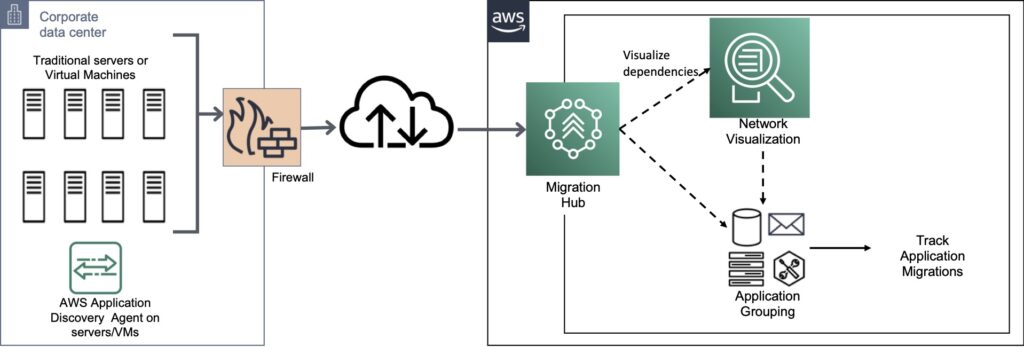
CLOUD REHOSTING
Rehosting essentially just moves your organization’s applications to the cloud platform as-is and is often called a “lift and shift” migration. That means that your core infrastructure is going to be the same, but now you’re getting the benefits and consumption based elastic resources in the cloud. Your applications are still going to have their own dependencies, and from a user level, everything is going to work very similarly to the way that it did before. Rehosting is a shift of infrastructure services such as network, compute, and storage from on-premises into a cloud service provider’s (CSP) cloud. There are many options depending on which hyper-visor you are invested in, such as Microsoft’s Hyper-V or VMWare. AWS provides a comprehensive product suite and management console for migrations: https://aws.amazon.com/migration-hub/ including on premises discovery, analysis and cloud migration sizing, patterns and tools to migrate applications, databases and do schema conversions.
Cloud rehosting is likely the most popular method of moving to the cloud because it causes such minimal disruption on all fronts. Organizations are able to utilize the advantages of the cloud without feeling the pressure to completely redesign their infrastructure. At the same time, that does mean that they are still using their old infrastructure, which may not ultimately be beneficial or future proofed. A cloud rehosting doesn’t necessarily take advantage of all the benefits of cloud services, and most organizations only see a reduction of about 20% on their capital expenses and a variable increase in the operational expenses to support the migration to the cloud. As customers who perform a rehost into a CSP, the long-term goal should be to optimize as much as possible out of Infrastructure as a Service and into more finished services such as Platform as a Service (PaaS) and Software as a Service (SaaS).
CLOUD REPLATFORMING
Replatforming is a level beyond cloud rehosting, under which some changes are made to take advantage of the cloud platform. While the applications are going to stay generally the same, some thought is put into how the cloud is going to be able to improve upon their use. There are going to be some minor changes to end-user activity and there is going to need to be more thought and work put into the transition. But ultimately, the system is more likely to work in a sustainable, long-term fashion.
But that doesn’t mean that cloud replatforming is inherently better, because not all organizations require replatforming. If their infrastructure is already working quite well, an organization may find that they only need cloud rehosting service. This is why the first step when choosing between cloud hosting or cloud replatforming should be to assess whether the current infrastructure is meeting the organization’s existing and future needs. Organizations who choose to replatform will need to keep workforce development in mind in order to train their staff to be comfortable with these newer cloud-based technologies like PaaS databases, etc.
CLOUD REBUILDING OR REFACTORING
It should also be noted that rehosting and replatforming aren’t the only cloud migration options. There are also the options of rebuilding and refactoring. Under a refactor, applications are altered to better suit the cloud environment, which can be an extensive process. This type of migration is also known as a “lift-tinker-shift”. Under rebuilding, the entire application may be rebuilt. So, there are layers to how the applications are transitioned to the cloud, in terms of intensity.
Organizations should execute an in-depth assessment of their own technology’s capabilities before they even decide to move to the cloud, because this in-depth assessment is what tells them how many changes need to be made to their application infrastructure when they’re moving toward the cloud.
Cloud resources aren’t the only thing that organizations can take advantage of, and cloud technology advances extremely fast compared to traditional application lifecycle management shrink wrap software releases. Whether applications can be transitioned directly toward the cloud is going to depend on the applications themselves and whether they are currently meeting the organization’s needs.
REHOSTING AND REPLATFORMING WITH AN MSP
A Managed Services Provider (MSP) can help assess and audit your organization’s current situation to determine whether you need a rehosting, a replatforming or one of the other migration-“Rs”. It could very well be that your organization can get optimal results through either, depending on how effective and productive your applications currently are. It could also be that your system requires one or the other, because your applications are lacking in some way or because your applications could be greatly improved through a few modifications.
Regardless of how extensive your rehost or replatform will be, an MSP can help you address it with minimal disruption and can help you make the most out of your cloud solution. The better your cloud transition is, the more money and time your organization will be able to save moving into the future.